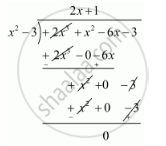Advertisements
Advertisements
प्रश्न
Find all the zeros of the polynomial 2x3 + x2 − 6x − 3, if two of its zeros are `-sqrt3` and `sqrt3`
उत्तर
we know that, if x = a is a zero of a polynomial, then x - a is a factor of f(x).
since `sqrt3` and `-sqrt3` are zeros of f(x).
Therefore
`(x+sqrt3)(x-sqrt3)=x^2+sqrt3x-sqrt3x-3`
= x2 - 3
x2 - 3 is a factor of f(x). Now , we divide f(x) = 2x3 + x2 − 6x − 3 by g(x) = x2 - 3 to find the other zeros of f(x).

By using that division algorithm we have,
f(x) = g(x) x q(x) + r(x)
2x3 + x2 − 6x − 3 = (x2 - 3)(2x + 1) + 0
2x3 + x2 − 6x − 3 `= (x+sqrt3)(x-sqrt3)(2x+1)`
Hence, the zeros of the given polynomial are `-sqrt3`, `+sqrt3`, `(-1)/2`.
APPEARS IN
संबंधित प्रश्न
Check whether the first polynomial is a factor of the second polynomial by dividing the second polynomial by the first polynomial
x3 – 3x + 1, x5 – 4x3 + x2 + 3x + 1
Give examples of polynomials p(x), g(x), q(x) and r(x), which satisfy the division algorithm
deg p(x) = deg q(x)
If the polynomial x4 – 6x3 + 16x2 – 25x + 10 is divided by another polynomial x2 – 2x + k, the remainder comes out to be x + a, find k and a.
Apply division algorithm to find the quotient q(x) and remainder r(x) on dividing f(x) by g(x) in the following f(x) = 10x4 + 17x3 − 62x2 + 30x − 3, g(x) = 2x2 + 7x + 1
Apply division algorithm to find the quotient q(x) and remainder r(x) on dividing f(x) by g(x) in the following f(x) = 4x3 + 8x2 + 8x + 7, g(x) = 2x2 − x + 1
What must be added to the polynomial f(x) = x4 + 2x3 − 2x2 + x − 1 so that the resulting polynomial is exactly divisible by x2 + 2x − 3 ?
Find the quotient and remainder of the following.
(8y3 – 16y2 + 16y – 15) ÷ (2y – 1)
The area of a rectangle is x2 + 7x + 12. If its breadth is (x + 3), then find its length
If on division of a polynomial p(x) by a polynomial g(x), the quotient is zero, what is the relation between the degrees of p(x) and g(x)?
If on division of a non-zero polynomial p(x) by a polynomial g(x), the remainder is zero, what is the relation between the degrees of p(x) and g(x)?
